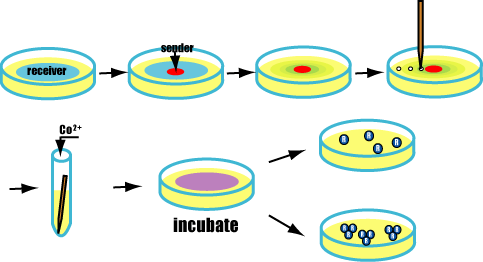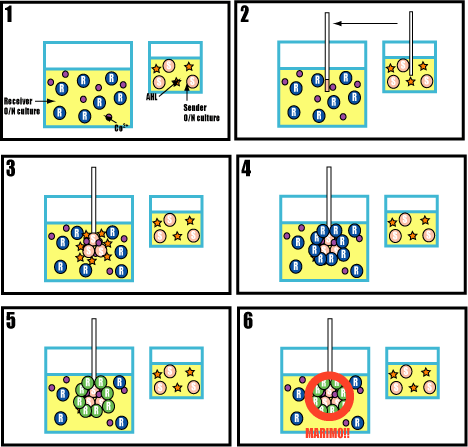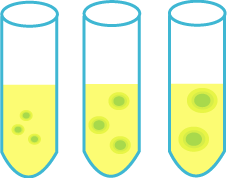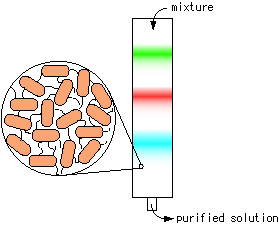Chiba/Goal
From 2007.igem.org
(→Method) |
(→Prediction) |
||
| Line 29: | Line 29: | ||
=====Prediction===== | =====Prediction===== | ||
If succeeded, cultures which is added imidazole will form a indipendent colony of senders&receivers. The other (non imidazole) will form colonies of adsorbed senders and receivers. | If succeeded, cultures which is added imidazole will form a indipendent colony of senders&receivers. The other (non imidazole) will form colonies of adsorbed senders and receivers. | ||
| - | |||
| - | |||
| - | |||
| - | |||
| - | |||
| - | |||
===A test to confirm a limit of size=== | ===A test to confirm a limit of size=== | ||
Revision as of 01:22, 27 October 2007
|
Introduction | Project Design ( 1.Sticky Hands | 2.Communication | 3.Size Control ) | Making Marimos | Our Goal || Team Members | メンバ連絡簿 |
Our Goal
As Final-Construction, we will carry out four experiments.
- A test of adsorption between flagella
- A test to confirm a limit of size
- A test to form Marimo
- A test of size control
A test of adsorption between flagella
Purpose
Confirm adsorption between senders and receivers with His-Tag.
Method
- Culture senders and receivers in a test tube.
- Drop senders into receivers tube and mix cobalt ion.
- Divide it into two groups. One is added imidazole and the other is non imidazole. Inoculate them on the plates.
- Check the colony.
Prediction
If succeeded, cultures which is added imidazole will form a indipendent colony of senders&receivers. The other (non imidazole) will form colonies of adsorbed senders and receivers.
A test to confirm a limit of size
Purpose
The purpose of this test is to confirm that Marimo has a limit of size on a plate.
Method
- Culture senders and receivers in a test tube.
- Inoculate receivers equally on the plate, and drop senders at the center of it.
- After over night,pick colonies which are near the senders (colonies express GFP), the end of the circle expressed GFP, and out of the green circle.
- Dilute them.
- Mix cobalt ion into dilutions and inoculate on the plates.
- Check the colony.
Prediction
If succeeded,receivers which don’t express FliC (they didn’t sense AHL and express GFP) form colonies one by one.
And receivers expressed FliC (they sensed AHL and expressed GFP) form aggregated colonies.)
↑プレートにまく前にイミダゾールを入れる/入れないの条件の違いが書いてないよ!?by tashiro ↑イミダゾールを混ぜる実験はadsorption test です。
↑スペリングミス。inculateではなくincubateですby とよたろ
A test to form Marimo
Purpose
Actually we make Marimos.
- AHL diffuse fast because it is very small molecule.
- Packed senders into a very thin capillary . AHL from it diffuse slowly and form concentrate gradients. Concentrate gradients enable Marimos to aggregate like a real ball.
(AHLはとても小さな分子で、自由度が高いので、拡散するのが早い。 キャピラリーを利用することによって、senderが生産するAHLの拡散を遅くし、AHLの濃度勾配を作ることができる。濃度勾配によってより球体に近いマリモができる。)
Method
- Culture senders and receivers in each test tube and mix Cobalt ions in receiver's tube.
- Add senders to receivers with a capillary.
- Check Marimos.
Prediction
If succeeded,AHL from senders spreads.
Receivers express GFP and FliC-His,and besides,bond with cobalt ions.
Finnally,form marimos.
A test of size control
Purpose
Control marimo's size by changing the ratio of amount of senders and receivers.
Method
- Culture senders and receivers in each test tube.
- Observe marimo's size by changing the amount of receivers and their types.(const.senders)
- Observe marimo's size by changing the amount of senders.(const.receivers)
Prediction
Low concentration of senders or receivers : Mini Marimo
High concentration of senders or receivers : Big Marimo
Future
- 説明がどれも不十分なので、もしどこが面白いのか充分に書けないのならば、この箇所はカットしましょう。byとよたろ
- Play catch with a big marimo.(サイズをもっと大きくしてマリモでキャッチボールがしたい)
- Make marimo in liposome.(リポソームの中でマリモを作る)
- Biochromatography using gelled cells.(ゲル化細胞を利用した、バイオクロマトグラフィ)





